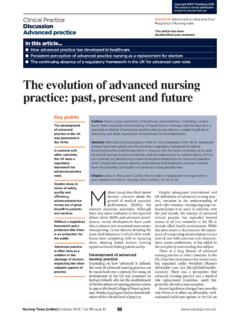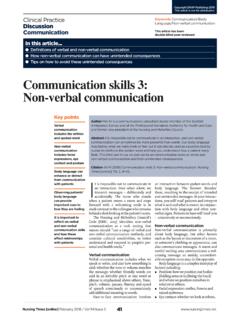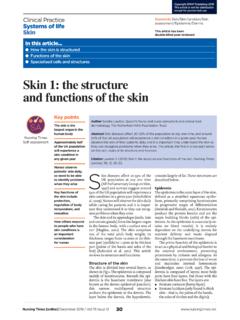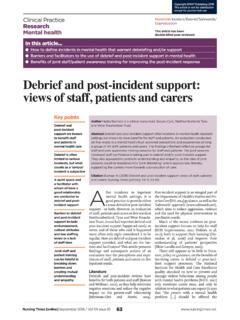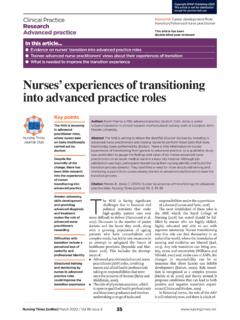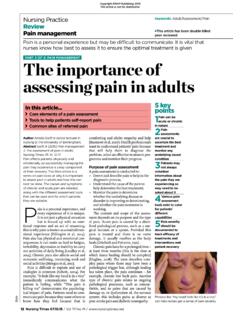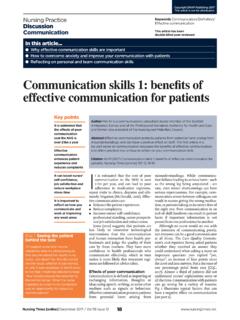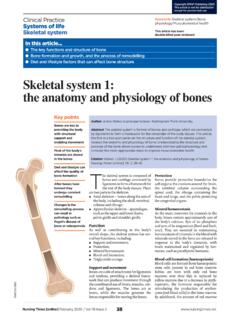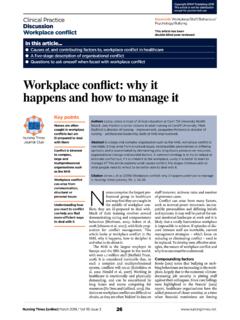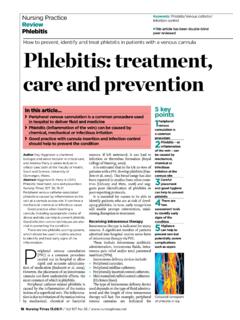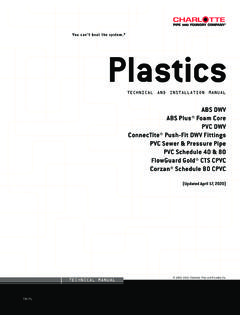Transcription of The physiology of blood pressure regulation
1 / Vol 112 No 43/44 / Nursing Times 17 Copyright EMAP Publishing 2016 This article is not for distributionKeywords: blood / blood pressure /Cardiac output/Fainting/Venous return This article has been double-blind peer reviewedAuthor Mike Lowry is former lead for clinical skills and simulation at The School of Nursing, University of Bradford; Julie Windsor is patient safety clinical lead medical specialties/older people at NHS Improvement; Sarah Ashelford is former lecturer in biosciences at The School of Nursing, University of Lowry M et al (2016) Orthostatic hypotension 2: the physiology of blood pressure regulation . Nursing Times; 112: 43/44,, response to certain situations, a series of actions take place in the body that can either raise or lower blood pressure . It is vital that nurses understand these actions and why they take place. This second article in a two-part series on orthostatic hypotension covers the anatomy, physiology and regulation of blood pressure .
2 Part 1 ( ) highlighted how the condition is linked to falls, why it occurs, who is at risk and how it can be identified and healthy people, each heartbeat forms a pressure wave that travels down the arterial system. The peak of the wave occurs during systole when blood is under pressure from cardiac contraction making the arterial wall expand. During diastole when the heart is briefly relaxing the arterial walls recoil, delivering a pulse (Lowry and Ashelford, 2015). Systemic circulation (Fig 1) provides oxygenated blood to all organs in the body. It is essential that this blood supply is maintained at all times. After perfusing the organs, blood is returned to the right atrium of the heart through the systemic venous key points 1 blood pressure must be regulated health problems occur if it is too high or too low 2 blood pressure can adapt to changing needs, such as increasing when people are in fight or flight mode or decreasing at rest 3 The autonomic nervous system controls adjustments to BP through the baroreceptor reflex 4 Certain illnesses or medications can compromise the functioning of the baroreceptor reflex5 Orthostatic hypotension can occur if BP does not adjust quickly enough after a sudden change in posture blood pressure (BP) adapts according to altered needs.
3 For example, when an increase is needed due to altered demands such as in a fight or flight response BP increases quickly until either the demand changes or needs for increased pressure are fully met. Conversely, when less pres-sure is needed to ensure adequate supply of blood for example, at rest BP reduces to its normal resting value. These rapid, short-term adjustments to BP are con-trolled by the autonomic nervous system (ANS) through the baroreceptor reflex. blood pressure regulationBP is the result of: Cardiac output (CO): the volume of blood that is pumped out of the left ventricle per minute; Systemic vascular resistance (SVR): the total resistance opposing blood flow within the systemic can be written as BP = CO x SVR. CO is a major factor determining BP; how-ever, as blood flows into the arterial system it meets resistance (in the form of friction) from contact with blood vessel walls.
4 The main resistance to blood flow occurs in the arterioles, which are smaller vessels formed from the branching of arteries; they are referred to as resistance vessels (Tortora and Derrickson, 2014). Resistance from all blood vessels in the systemic cir-cuit combines to produce the SVR, which increases BP in the systemic arterial system. These two factors together CO and the SVR generate actual BP in the sys-temic arterial system. Role of autonomic nervous systemCO and SVR are adjusted on a moment-by-moment basis to ensure BP meets the In this Anatomy and physiology of blood pressure Why regulating blood pressure is so important Factors that affect the functioning of the baroreceptor reflexRegulation of the blood pressure is a vital physiological process enabling the body to respond to immediately changing demands such as fight or flight , or restingThe physiology of blood pressure regulation ORThOsTATiC hyPOTeNsiON: PART 2 OF 2 Nursing PracticeReviewVital / Vol 112 No 43/44 / Nursing Times 18 Copyright EMAP Publishing 2016 This article is not for distributionCOArterialBPSVRVRFor more articles on blood pressure , go to wall.
5 When BP rises, arterial walls are stretched more and the baroreceptors are stimulated to fire more frequently. If BP drops, the stretch of the arterial walls decreases and the baroreceptors fire less frequently. The nerve impulses pass from the baro-receptors to the medulla in the brainstem where nerve centres regulate activity of the sympathetic and parasympathetic nerves. A sudden decrease in arterial pressure will decrease baroreceptor firing, increase the sympathetic outflow and decrease the parasympathetic outflow. These changes will cause vasoconstriction of the arteries and arterioles, which increases SVR. Sym-pathetic outflow to the heart causes an increase in heart rate and force of contrac-tion, increasing CO. Increased systemic vascular resistance and increased CO together raise the BP.
6 In contrast, if the BP increases, the baroreceptors will be stimulated to fire more frequently. The medulla will respond by increasing parasympathetic output and decreasing the sympathetic output. This will result in a decreased CO and systemic vascular resistance and, thus a drop in blood following are clinically relevant sit-uations in which the baroreceptor reflex may be hypotensionOrthostatic hypotension occurs when there is a sudden drop in BP due to a change in a person s position. On moving from sitting to standing, or from lying down to standing, gravity acts on the vas-cular system to reduce the volume of blood returning to the heart and blood pools in the leg (Fig 3). The lower venous return reduces the volume of blood that is avail-able to pump out of the heart, which causes a drop in CO and a momentary drop in BP.
7 This drop can be particularly marked when moving from lying down to standing and can increase the risk of falls (see part 1 of this series at ).VasoconstrictionThe main factor influencing SVR is the diameter of the arterioles, which are sup-plied with sympathetic nerve fibres that, when stimulated, cause the smooth muscle in the wall of the arterioles to contract. Con-traction of the smooth muscle causes the arterioles to constrict. This is an example of vasoconstriction (Fig 2), which increases the resistance to the flow of blood and, therefore, increases SVR. It is an important way of increasing BP and, again, will occur during exercise or a fight or flight response, when increased BP is needed. Role of venous returnThe volume of blood returning to the heart is called venous return. If this increases, more blood returns to the heart, stretching the myocardium (muscle making up the wall of the heart).
8 The more the myocar-dium is stretched, the more forcefully it contracts an increase in venous return causes an increase in stroke volume and CO. Increases in venous return are impor-tant during exercise, when skeletal muscles contract more often and force-fully. This squeezes blood in the veins and results in a greater volume of blood returning to the heart. In contrast, if there is loss of blood through haemorrhage, it will result in decreased blood volume and a decrease in venous return. This is why BP drops after significant blood loss. Understanding the physiology under-lying BP is vital to understanding the baroreceptor reflex and its importance in BP control. The baroreceptor reflex This is an autonomic reflex that acts to maintain BP in the short term and, in par-ticular, in response to changes in posture, such as when moving from sitting or lying down to standing, when gravity can cause BP to fall.
9 The baroreceptors are receptors located in the walls of the arteries at the carotid sinus and aortic arch. They act as pressure sensors, detecting changes in arterial BP through the stretch of the body s needs. CO is the product of heart rate and stroke volume, which can be rep-resented as CO = HR x rate is the number of heartbeats per minute and can be measured by assessing the pulse, which is regulated through the ANS (Lowry and Ashelford, 2015). The heart has a dual nerve supply from the two branches of the ANS: sympa-thetic and parasympathetic. Increasing sympathetic stimulation to the heart increases the heart rate and the force with which it contracts. This leads to an increase in stroke volume, producing an increase in CO. The same increase in heart rate and force of contraction occurs in response to increased levels of the hormone adrenaline.
10 These effects occur, for example, during exercise or a fight or flight response. The force with which the heart contracts also depends on the volume of blood returning to it. Increased force of contraction of the heart is often felt as pal-pitations and can lead to a feeling of anxiety. Decreases in heart rate occur through decreasing sympathetic activity and reduc-tions in circulating levels of adrenaline. Increasing the parasympathetic stimula-tion to the heart reduces the heart rate. The sympathetic and parasympathetic actions oppose each other and allow the heart rate to be fine-tuned . fIg 1. sysTemiC CiRCulATiONfIg 2. VAsOCONsTRiCTiON Sympathetic stimulation of the arterioles causes vasoconstriction through contraction of the smooth muscle in the walls of arteriolesSmooth muscle contractedSmooth muscle relaxedDilatedVasoconstrictionBP = blood pressure , CO = cardiac outputSVR = systemic vascular resistance VR = venous returnNursing / Vol 112 No 43/44 / Nursing Times 19 Copyright EMAP Publishing 2016 This article is not for distributionReduced blood volume blood loss (haemorrhage) leads to lowered blood volume, which, in turn, reduces venous return and pressure , leading to hypotension.
